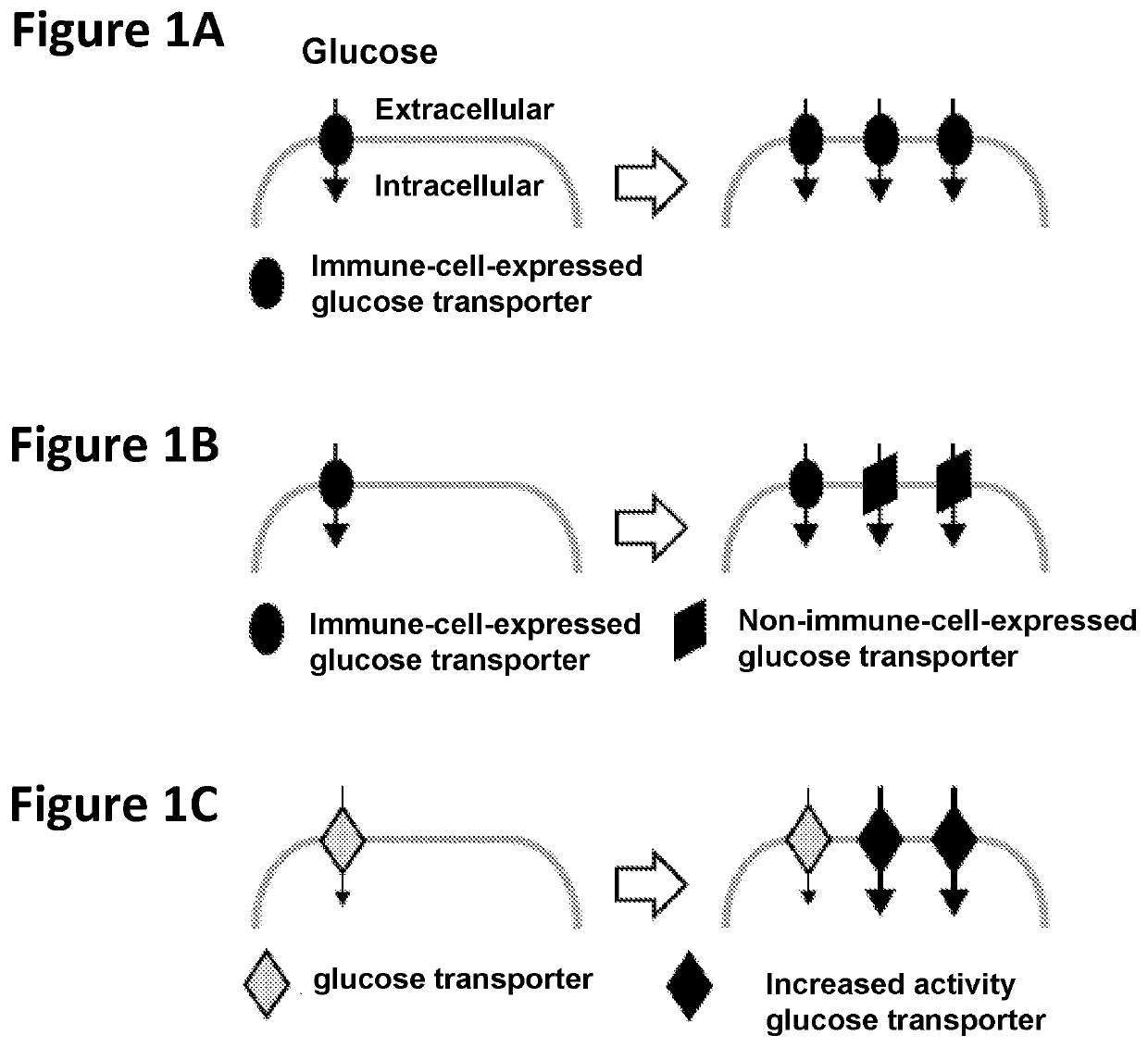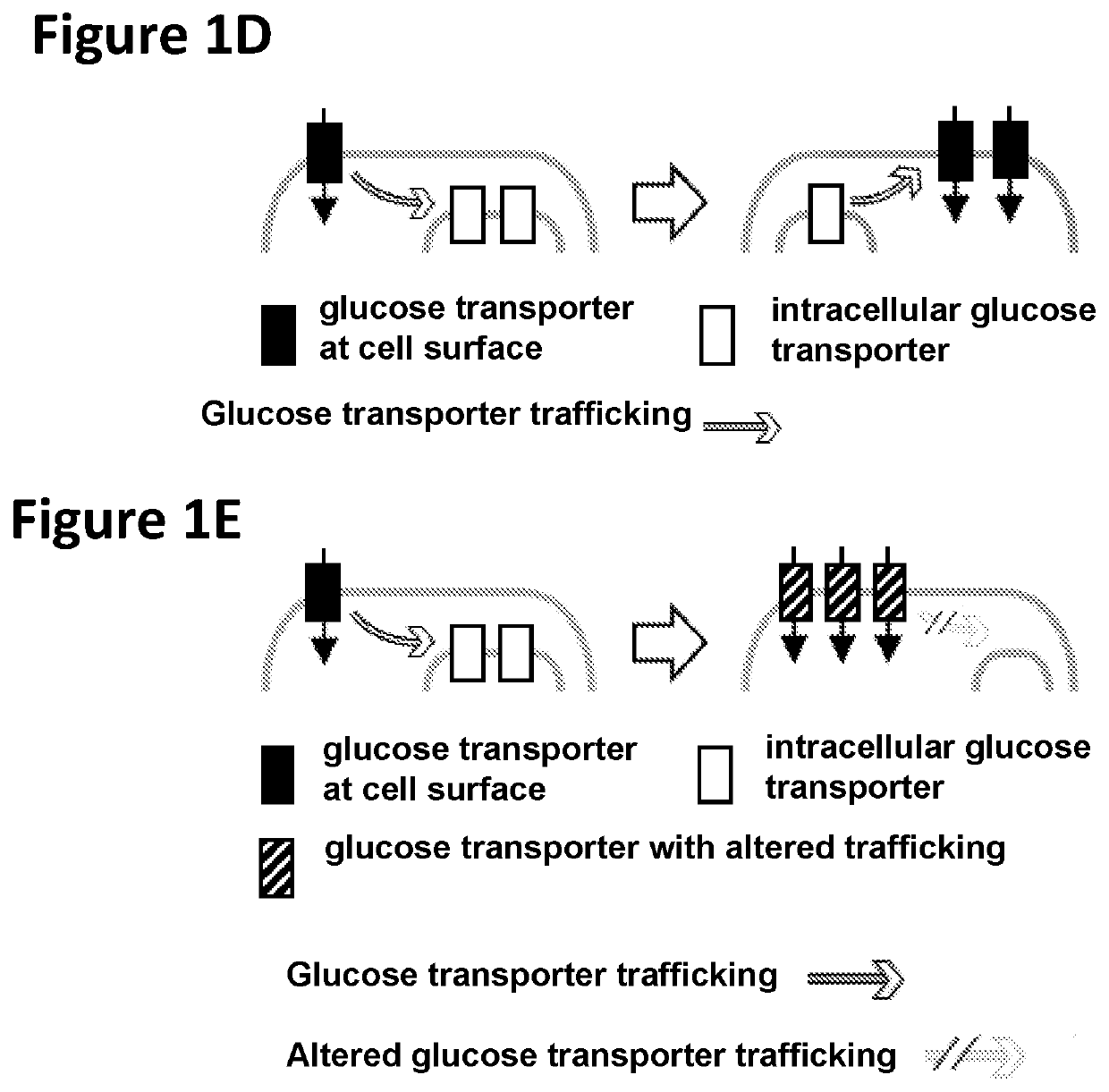Chimeric receptors in combination with trans metabolism molecules enhancing glucose import and therapeutic uses thereof
a technology of chimeric receptors and trans metabolism molecules, applied in the field of0002cancer immunotherapy, can solve the problems of t cell activation and trigger cytotoxicity, and achieve the effects of increasing glucose uptake, enhancing glucose uptake, and increasing glucose uptak
- Summary
- Abstract
- Description
- Claims
- Application Information
AI Technical Summary
Benefits of technology
Problems solved by technology
Method used
Image
Examples
example 1
Expressing a Glucose Importation Polypeptide on T Cell Function in Lower Glucose Environments
[0249]A glucose importation polypeptide transgene is co-expressed in the same T cell with an ACTR polypeptide. The transgene is, for example, GLUT1, GLUT1 S226D variant, GLUT3, GLUT8, GLUT8 L12A L13A variant, GLUT11, GLUT7, GLUT4, SGLT1, or SGLT2 (e.g., SEQ ID NOs:81-90). The T cells are transduced with a virus encoding the ACTR polypeptide and the glucose importation polypeptide separated, for example, by a P2A ribosomal skip sequence. The T cells are mixed at a given effector-to-target (E:T) ratio with tumor target cells, such as IGROV-1 cells, and a tumor-targeting antibody such as an anti-FOLR1 antibody. Reactions are then incubated at 37° C. in a 5% CO2 incubator for a period of time (e.g., 6-8 days) at different starting concentrations of glucose (e.g., 0-20 mM). T cell function is then evaluated, for example, using cytokine production or T cell proliferation assays. Cytokine productio...
example 2
Expressing a Glucose Importation Polypeptide Gene on T Cell Function in Environments with Higher Soluble Inhibitor Concentrations
[0250]A glucose importation polypeptide transgene is co-expressed in the same T cell with an ACTR polypeptide. The transgene is, for example, GLUT1, GLUT1 S226D variant, GLUT3, GLUT8, GLUT8 L12A L13A variant, GLUT11, GLUT7, GLUT4, SGLT1, or SGLT2 (e.g., SEQ ID NOs:81-90). The T cells are transduced with virus encoding the ACTR polypeptide and the glucose importation polypeptide separated, for example, by a P2A ribosomal skip sequence. Transduced T cells are mixed at a given effector-to-target (E:T) ratio with tumor target cells, such as IGROV-1 cells, and a tumor-targeting antibody such as an anti-FOLR1 antibody, in media containing different concentrations of soluble inhibitors that are present in the tumor microenvironment (e.g., TGFbeta, PGE2, and / or adenosine). Reactions are then incubated at 37° C. in a 5% CO2 incubator for a period of time (e.g., 6-8...
example 3
Expressing a Glucose Importation Polypeptide on T Cell Function in Environments with Greater Immunosuppressive Cell Presence
[0251]A glucose importation polypeptide transgene is co-expressed in the same T cell with an ACTR polypeptide. The transgene is, for example, GLUT1, GLUT1 S226D variant, GLUT3, GLUT8, GLUT8 L12A L13A variant, GLUT11, GLUT7, GLUT4, SGLT1, or SGLT2 (e.g., SEQ ID NOs:81-90). The T cells are transduced with virus encoding the ACTR polypeptide and the glucose importation polypeptide separated, for example, by a P2A ribosomal skip sequence. Transduced T cells are mixed at a given effector-to-target (E:T) ratio with tumor target cells, such as IGROV-1 cells, and a tumor-targeting antibody such as an anti-FOLR1 antibody, in the presence of immunosuppressive cells (e.g., myeloid-derived suppressor cells and / or regulatory T cells). Reactions are then incubated at 37° C. in a 5% CO2 incubator for a period of time (e.g., 3-10 days). T cell function is then evaluated, for e...
PUM
| Property | Measurement | Unit |
|---|---|---|
| dissociation constant | aaaaa | aaaaa |
| dissociation constant | aaaaa | aaaaa |
| dissociation constant | aaaaa | aaaaa |
Abstract
Description
Claims
Application Information
 Login to View More
Login to View More - R&D
- Intellectual Property
- Life Sciences
- Materials
- Tech Scout
- Unparalleled Data Quality
- Higher Quality Content
- 60% Fewer Hallucinations
Browse by: Latest US Patents, China's latest patents, Technical Efficacy Thesaurus, Application Domain, Technology Topic, Popular Technical Reports.
© 2025 PatSnap. All rights reserved.Legal|Privacy policy|Modern Slavery Act Transparency Statement|Sitemap|About US| Contact US: help@patsnap.com



